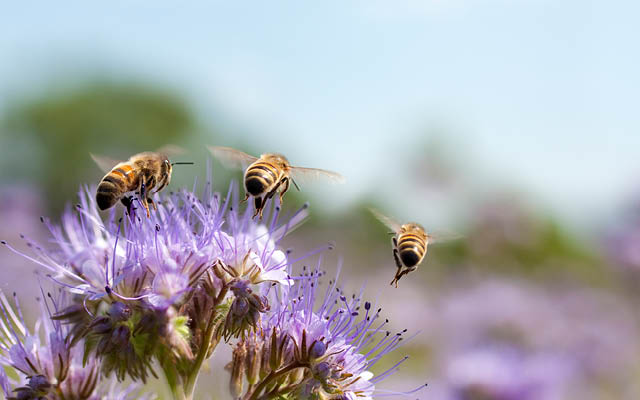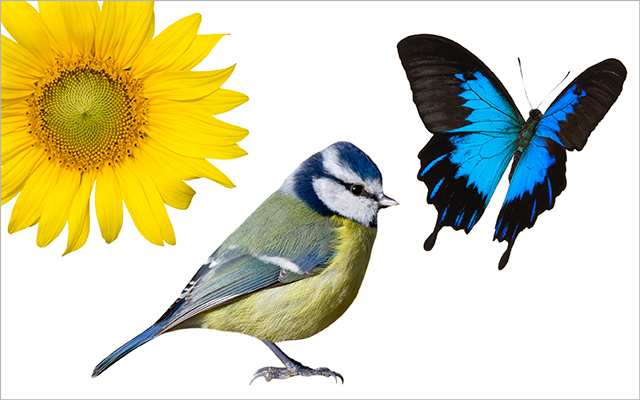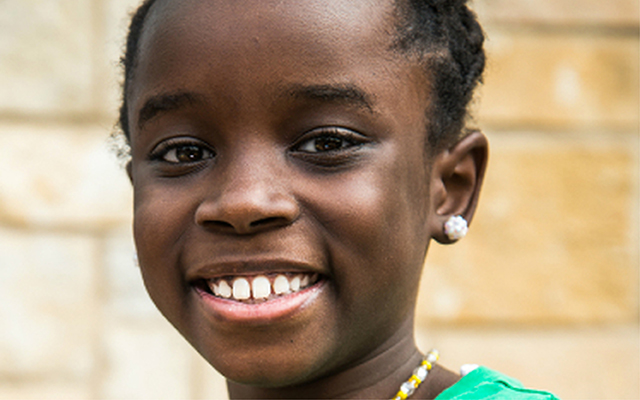Scientists have long known that bees and other pollinators are important keystone species. They disproportionately affect a natural environment relative to their abundance, and they’re critical in maintaining ecosystems. They’re also vital to global food supplies and economies. Consider these examples:
- Three-quarters of the world’s flowering plants and more than a third of its food crops rely on animal pollinators for reproduction. The presence of native bees increases crop yield.
- More than half of our fats and oils (palm, canola, sunflower) come from animal-pollinated plants.
- More than 150 food crops in the United States depend on pollinators, including almost all fruit and grain crops.
- The USDA estimates that pollinator-dependent crops are worth more than $10 billion per year.
Pollinator Profiles
Studies have revealed a dramatic decline in insect populations worldwide. This matters because mosquitoes, beetles, wasps, and flies all play an essential role in pollination. Meet some of the other key players and learn about the factors putting them at risk.
Bees
We’re known for being busybodies. You’ve likely seen us bumblebees (there are more than 250 species) filling the baskets on our legs or abdomens with pollen to bring to our hives and inadvertently carrying pollen on our furry bodies from one flower to another.
Or perhaps you’ve tried the sweet treat made by our honeybee relatives. Speaking of them, did you know that commercial honeybees are transported thousands of miles to pollinate almond trees in California and apple and cherry trees in Michigan? They also help grow strawberries, avocados, kidney beans, coffee, flax, and walnuts, to name just a few examples.
In the past two decades, managed-honeybee numbers have dramatically declined, partly because of colony collapse disorder — a sudden loss of a colony’s worker bees, which are necessary to sustain the colony. Meanwhile, many bumblebee species in Europe and North America have gone locally extinct.
The reasons for our massive casualties are complex, but parasites and diseases, pesticides, insufficient food and nesting resources, and climate change are all likely contributors.
Birds
You know us as colorful crooners, but the hummingbirds, spiderhunters, sunbirds, honeycreepers, and honeyeaters among us are prolific wildflower pollinators. We’ve hardly met a brightly colored — red, yellow, or orange — tube-, cup-, or funnel-shaped flower that we haven’t liked.
In fact, the iconic giant saguaro cactus, found in the Sonoran Desert, could not reproduce without the assistance of white-winged doves, who sip nectar from the cacti blooms.
Recent studies have revealed sharp losses in our fellow populations across Europe, while another report noted that 3 billion of us have been lost in North America since the 1970s.
Your household outdoor cat does more than ruffle our feathers; it increases our mortality rates, as do pesticides, climate change, and glass-window strikes. Annual illegal hunting of millions of migrating songbirds continues to reduce our numbers across southern Europe and the Middle East.
Butterflies, Moths, and Skippers
We’ve long been ambassadors of nature, brightening backyard gardens and pollinating many flowers in wild spaces. We’re noted cultural and spiritual icons of transformation and rebirth.
We’re tiny but mighty! Monarchs are legendary for their herculean, multigenerational migratory journey from Mexico to Canada. Painted ladies travel up to 100 miles a day and top out at speeds of 30 mph.
We’ve also become harbingers of widespread environmental changes. Lepidopterans are one of the most diverse insect groups, but monarch numbers alone have plummeted by 90 percent in the last 20 years. Fifteen of our species disappeared completely from the Netherlands between 1890 and 2017.
Loss of habitat and plant diversity, agrochemical pollutants, climate change, and invasive species all threaten our survival.
Bats
We’re the only mammals that can fly, and we have serious echolocation skills. We sometimes carry disease, but we’re mostly harmless to humans. In fact, many people prize our droppings (guano) as fertilizer.
We’re naturals at pest control, consuming vast amounts of harmful agricultural bugs and other insects. Our nectar-feeding brethren pollinate cacti and agave in North American deserts as well as a wide variety of plants in the tropics. The great baobab tree of the African savanna — known as the African Tree of Life because of the number of wild species that depend on it — relies solely on us for pollination. Up to 98 percent of all rainforest regrowth comes from seeds that have been spread by fruit bats.
White-nose syndrome — a fungal disease attacking those of us who hibernate in caves through the winter — has killed millions of us in the United States and Canada in recent years. Our flight patterns and love of tree roosting increase our risk of collision with wind turbines.
Canaries in the Coal Mine
Pesticide use, parasites and disease, habitat loss, monoculture farming, and changing climate are all thought to be major factors in the dramatic worldwide decline of these critical pollinators.
In recent years, several bee varieties — including the once-common rusty patched bumblebee — have been added to the endangered species list, joining three types of bats, five birds, and 24 butterflies and moths. Though bats are an understudied group of mammals, 24 bat species are listed as critically endangered (facing imminent threat of extinction), 53 are listed as endangered, and 104 are considered vulnerable.
Two-thirds of North American birds are considered to be at increasing risk of extinction from rising global temperatures.
But all is not lost. To support these important indicator species, we can start taking action:
- Buy organic food and shade-grown coffee.
- Avoid using pesticides and herbicides in your yard. Try nontoxic pest-control methods — like crop rotation and row covers — first. If you must use pesticides, remember to read the label; some pesticides can harm bees. Use chemicals properly and spray at night, when pollinators are least active.
- Foster natural habitats. Seventy percent of bees live in ground nests, while others live in clumps of grass or tree limbs and stumps. Leave uncovered dirt in your yard, and leave some fall leaf cover until spring, to provide habitat and protection over the winter. If you buy mason bee or butterfly houses, choose those you can take apart and clean properly to protect nesting pollinators from parasites.
- Plant pollinator-friendly and native-to-your-area plants, shrubs, and trees: Monarchs love milkweed, for example. Common and swamp milkweed and butterflyweed are three varieties that grow well in many regions. Find databases at www.audubon.org and nanps.org/native-plant-societies.
- Offer additional food sources with bird feeders, dried mealworms for ground-eating birds like robins, and overripe bananas and other fruit for butterflies. Clean feeders regularly.
- Provide fresh water in birdbaths, bee baths, and dishes containing moist, sea-salted sponges to provide nutrients for butterflies. Clean baths frequently.
- Use bird-friendly window coverings to prevent collisions. Learn more at www.abcbirds.org.
- Become a citizen scientist by helping advocacy groups count pollinators. (Learn how at “How to Be a Citizen Scientist”.)
- Spread the word about the plight of pollinators and why they matter; advocate for pro-pollinator environmental policies; and support conservation efforts by pollinator-advocacy groups, such as the Xerces and National Audubon Societies.
This originally appeared as “The Bees Knees” in the May 2020 print issue of Experience Life.




This Post Has 0 Comments